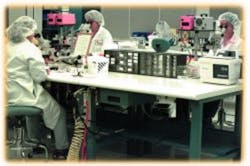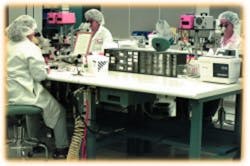Biomedical Instrument Maker Welcomes S20.20 Standard
When the Beckman Coulter manufacturing assembly unit joined product development at its facility in Kendall, FL, a few months ago, the ESD team selected ANSI/ESD S20.20, primarily because it offers a single set of ESD guidelines that applies uniformly throughout the electronics industry. In addition, the standard’s compliance options are useful and complement the corporation’s global policy on ESD control.
A Merger of Two Biomedical Firms
Beckman Coulter originated as two separate companies. Beckman Instruments dates back to the 1930s, when California scientist Arnold O. Beckman, Ph.D., invented the pH meter. Coulter was founded in Chicago in the 1940s when brothers Wallace and Joe Coulter invented a blood cell counter that transformed the scientific analysis of cells and other microscopic particles.
Coulter moved to Hialeah, FL, in the 1960s and continued to advance the field of automated hematology analysis through the application of the Coulter Principle. Beckman and Coulter became one company in 1997. Home for part of the Beckman Coulter operation was an industrial site at Kendall. Recently, the manufacturing assembly unit was moved there; however, the PC board operation and reagent manufacturing operations remain at the Hialeah plant.
Biomedical Products Need ESD Protection
Virtually all products manufactured at Kendall and Hialeah contain electronic components vulnerable to low levels of ESD. In general, ESD control measures should provide protection down to 100 V or less wherever possible.
Many of the company’s products represent sizeable investments for customers, with price tags ranging from tens of thousands to several hundred thousand dollars. Defective components, though rare, can lead to significant field-service costs and risk loss of customer confidence. Beckman Coulter managers support the philosophy that field failures due to ESD damage are preventable, so it makes sense to invest in the best possible ESD protection.
The company’s earliest ESD control program was introduced in the 1970s. It consisted of wrist straps that grounded personnel and tablemats that reduced static charge on worksurfaces. During the 1980s and 1990s, as standards emerged in the electronics industry, the company responded by tightening control in ESD-safe areas. Employees tested their wrist straps daily to ensure proper functioning, and a surface-coated conductive floor was installed in selected areas of the plant.
In addition, the facility focused on protecting components in transit between ESD-safe areas. When sensitive items were moved within the plant or taken on field-service calls, they were placed inside ESD-protective bags. Field-service kits included wrist straps for technicians to wear while working at customer sites.
In fact, packaging was so important that twice in the 1990s the company assisted 3M in redesigning and testing a static-shielding bag. The results included a cushioned bag for physical as well as ESD protection and a version with a mechanical closure.
New Standard Brings Clarity and Options
The release of ANSI/ESD S20.20 in late 1999 by the ESD Association gave Beckman Coulter’s manufacturing operation a new standard to complement existing corporate policies and guide ESD control practices. The company’s ESD control team welcomed this development because of past experience with multiple, and sometimes contradictory, standards used by regulators, contractors, suppliers, vendors, and customers. In addition, the options listed for complying with the requirements offered latitude in dealing with varying economic and practical considerations at different sites.
The ESD control team investigated constant monitors as an option for complying with S20.20 requirements for ESD protected areas. Experience had shown that periodic testing of wrist straps did not detect a strap malfunction that occurred later in the day or an intermittent grounding lapse if the wearer tugged at the strap. Nor did arbitrary testing pick up connection problems.
After evaluating 10 different monitors, the ESD control team chose the 3M Model 724 because the dual-conductor system, which measures loop resistance, performed with the greatest accuracy. Also, the monitor alerts operators the instant a bad connection occurs. Apart from ESD considerations, continuous monitoring improves employee productivity by eliminating time used in testing and logging results.
Moving manufacturing into a facility designed and built to the company’s specifications gave the ESD control team an ideal opportunity to incorporate improvements. Because this building needed a new layer of concrete to level the floor, the ESD control team selected an ESD flooring/footwear system, an S20.20 option for personnel grounding.
Today, employees wear conductive shoes, heel straps, or toe straps that discharge static to the flooring, which is grounded to the building’s electrical system. The flooring converted the entire 60,000 square feet of the manufacturing area into an ESD-protected zone, which is ideal when workers move about frequently and roll carts and equipment between workstations.
The team weighed many factors in specifying ESD control flooring. Characteristics such as ease of repair, replacement, expansion, durability under light-to-moderate foot and equipment traffic, and the capability to maintain static-control properties without waxing were considered. Aesthetics also figured into the decision.
The resulting selection was 3M 8400 Series Static Conductive Tile, a white tile with blue flecks that meets the ESD needs and provides a clean, ultramodern look and feel. Its no-wax feature means the floor will retain its white, shiny appearance with only minimal mopping and buffing.
In both of the Miami-area facilities, each production worker wears a white lab coat in addition to a wrist strap and/or footwear. The ESD control team chose a 20% cotton coat for its static-attenuation feature as well as wearer comfort and durability through frequent launderings.
The distance between the two manufacturing facilities means that PC boards are transported, so they need ESD packaging. For this, the team chose 3M ESD tote boxes rather than bags because the sturdy construction withstands the daily 50-mile round trip and the filling and emptying at each end. In addition, ESD bags are used to transport single components on field-service calls and carry items within the plant.
Employee training always has been important in the company’s ESD control program. Several years ago, an in-house database was created to document the training individuals received. Last year, in anticipation of the move into the new manufacturing facility, the training coordinator began instructing personnel on the new ESD-control equipment and procedures. In addition, an ESD refresher course has been instituted that all Miami-area production workers must complete each year.
Having had the rare opportunity to install ESD control features in a newly constructed environment, the Beckman Coulter team has gained a great deal of valuable experience that will be beneficial throughout the organization. The Miami-area operation has elected to adopt the S20.20 to complement existing company-wide practices because the standard provides one-stop shopping in ESD control and is recognized as a mark of world-class manufacturing.
About the Author
Ed Myscich, senior technical operations engineer at Beckman Coulter’s Miami-area operation, holds a degree in electrical engineering from the University of Miami. Before assuming his present position in 1994, he worked for Racal Milgo for 14 years. Beckman Coulter, 11800 SW 147th Ave., Miami, FL 33196-2500, 305-380-2390, e-mail: [email protected]
October 2001

